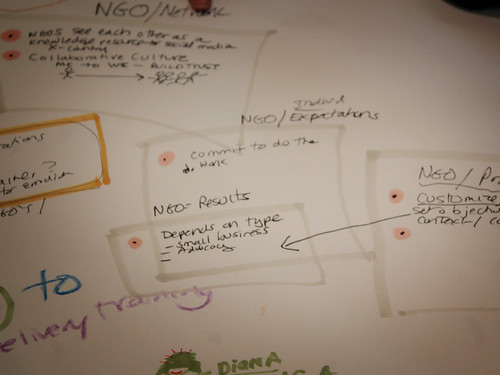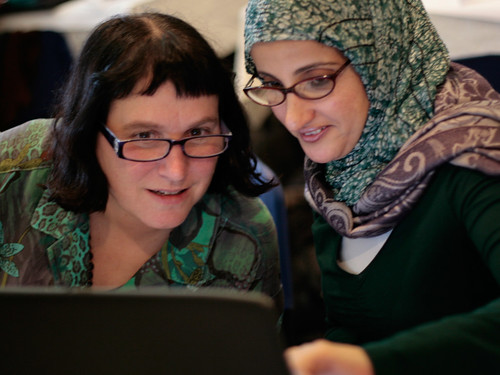
Beirut Diary: I’m in Beirut for the week as part of The E-Mediat project, a capacity building project that leverages a networked approach. I’m the lead for Zoetica where my role is to deliver training, advise on the curriculum and coaching methods, model transparency, and serve as meta network weaver. I have the honor of co-training with some of the best folks doing work in this part of the world. (Here’s the posts from Day 1 and Day 2)
The E-Mediat project is sponsored by MEPI, US Department of State’s Middle East Partnership Initiative and was created in response to Secretary Clinton’s announcement of Civil Society 2.0. The project is being managed by IIE and builds on a highly successful program launched in the Middle East five years ago, Women in Technology that trained over 10,000 women from 9 countries in the Middle East and in collaboration with over 60 training partners. A true public/private partnership, the funding partners include Microsoft and craiglist Charitable Fund.
Day 4 of the Train the Trainers E-Mediat was designed and facilitated by the capable SMEXbeirut Team – including Jessica Dheere, Mohamad Najem, Hanibaael Haim and Naeema Zarif.
As a trainer, sometimes we get into “ruts” where we use the same exercises and that can make you less passionate about your work. One way to rejuvenate your practice, is to be a participant in training designed and facilitated by someone else. The day provided lots of inspiration and new ideas designing and facilitating training.
It never ceases to amaze how the set up of the room influences how we learn and how important that is to consider it in your design. The ways tables and chairs and the screen are placed in the room can work against your instructional style or support it.
Naeema Zarif started us off with an energizer that involved our respective countries National Anthems. The national anthem from Tunisia brought tears to my eyes – in part – because feeling in which they sang it – and the team leader, Chema, has a beautiful singing voice.
In the above video, Naeema Zarif. explains the how and why.

The morning used the World Cafe technique. I first met Juanita Brown who created the method through my blog in 2006. I later became a member of the GIGI group (girl geeks of the World Cafe). The world cafe technique is where participants learn through conversation in small groups. It is an effective technique to use to help participants process what they’ve learned and to harvest insights. Here’s how it was used during Day 4.
The two discussion questions were:
- What are your expectations for the project as a social media trainer?
- What are your expectations about the outcomes for NGOS?

In my group, we identified four broad themes for the first question:
- Improved training technique
- Fluency in social media skills
- Integrating the training and social media
- Mastery of Train of the Trainer design and delivery
Related to the NGOs, our group discussed what the short, medium, and long-term outcomes might be. We had a rich conversation about overall design – the process of vetting participants, participant expectations, and their commitment to do the work. For outcomes, we identified a few:
- NGOs share their knowledge with one another
- NGOs master the skills and put them into practice
- NGOS work as a network to reach broader civil society goals
The debriefing prompted a wide range of insights, particularly how to facilitate a training when you have individuals with a wide range of knowledge and skills. Some tips:
1.) Remember to use the phrase, “I don’t know, I’ll find out.”
2.) Use the icebreaker as an assessment and do a pre-survey so you know who has what knowledge and skill level
3.) Honor the more advanced participants and make them teaching assistants
4.) Do real-time “network weaving” by pointing out knowledge in the room.
5.) Use participant examples of part of your presentation or have them share.
The next session (conducted in Arabic) was a demonstration of listening tools for social media trainers. The notes are captured here. The delivery was a more formal presentation and demonstration, with full group q/a. Having the small group exercise come first – was useful because people were able to take in the great content presented. The wiki also included how-to handouts to use later.
The session after lunch is always difficult because energy drops and people are tired. Naeema Zarif lead us through a fun icebreaker that involved dancing and prizes. Moving around woke everyone up and we were ready to pay attention.
After lunch, we did an exercise where we used different social media tools to explain a social media concept. Each group was told to use words, text, audio, or video and then we presented to the whole group.
Our group was assigned words, but we all discovered that we were visual learners so we used both words and visuals, playing with flickr and adding the photos to the wiki. I modeled a train-the-trainer technique called “Shoulder to Shoulder Learning.” Here’s how it works with a group of 4:
1. Trainer models the steps to the three others, slowly – narrating what they are doing.
2. Trainer becomes the student and has another participant guide them through the same steps. The trainer models being a uncomfortable student or one that makes a mistake or asks questions when something unexpected happens.
3. Next, the other two participants take turns being the trainer or the student.

The last session used a classic trainer’s technique, a verbal evaluation of the day. Here are the instructions. This is helpful with multi-day trainings so you can adapt and adjust in the next days.
Through observing other (good) trainers, you can learn a lot of about technique. You can even learn a lot from observing trainers who are new because you think about how you might modify what they did. All in all, I observing the training was a creative catalyst for lots of new ideas about training design and facilitation techniques, but I’ll save sharing those for a later post.
Thank you SMEXbeirut!

Leave a Reply